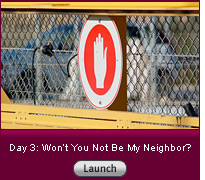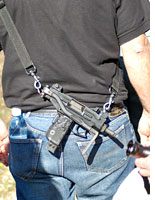A Terror Tour of Israel
Call it what you want—temporary security measure, border crossing, segregation wall—Checkpoint Eliyahu is part of the emerging geography of Israel and the Palestinian territories. The checkpoint, which straddles the highway between the West Bank towns of Qalqilyah and Nablus, is the perfect vantage point for viewing Israel's security fence, the defining feature of this new landscape. Israel began fencing off areas of the West Bank in the summer of 2002, claiming a legitimate defense against infiltration by suicide bombers and other violent attacks. A visit to the fence is now a mandatory stop on any roadside tour of the Holy Land.
We had picked up our guide, Capt. Noa Meir, outside Qalqilyah, the small Palestinian town at the edge of the West Bank that has become one of the most dramatic examples of the wall. Qalqilyah was not simply walled off from Israel. Because of the location of Israeli settlements to the north and south, the Palestinian town was quite literally fenced in. Residents of the city, who once had extensive commerce with Israelis, aren't just separated from Israel; they are separated from the world.
Meir, a U.S.-born Israel Defense Forces spokeswoman, escorted our group over to the military watchtower that looms over a section of the wall outside the town. "The people defending us are not very happy we're here," she said. "There can be sniper fire." She distributed copies of "Israel's Security Fence: Defending Innocent Civilians From Terror," a brochure crowded with statistics and talking points. ("[T]he land used in building the security fence is seized for military purposes, not confiscated. … [S]pecial arrangements have been made for Palestinian farmers separated from their lands. … The security fence, whose only function is to provide security, does not seal off the West Bank.")
From Qalqilyah or Tulkarem, the western edge of the West Bank, it's only about 10 miles to the Mediterranean Sea. Yet standing within spitting distance of an Arab town—one that elected a Hamas mayor, no less—clearly makes some members of our tour group uncomfortable, sometimes to comedic effect. We suddenly notice that Yossi Maimon, our tour guide and history lecturer, had a Mini-Uzi draped behind his back. One of the U.S. security consultants knelt nonchalantly in the dust. ("Don't want to be a sniper target," he explained to us later.) As we walked down the road, we half-expected someone to cry out, "Serpentine, Shel! Serpentine!"
We rode with Meir to Checkpoint Eliyahu, where donkey carts waited in line next to passenger cars. At the checkpoint, there is no solid concrete wall—the fence is more like a military frontier or demilitarized zone, with a layered series of barriers that includes a ditch to prevent vehicle crossings, tightly coiled stacks of concertina wire, and intrusion-detection fences with pre-tensioned wires that can detect the slightest movement. Israeli security forces monitor the buffer zone with an array of high-tech surveillance equipment: cameras, pressure sensors, and thermal-imaging devices. Bedouin trackers patrol the dirt roads adjoining the barrier, looking for errant footprints.
The portion of the fence between Qalqilyah and the Israeli town of Kfar Saba is a concrete barrier around 28 feet high. The main purpose, according to the Israelis, is to prevent snipers from firing into Kfar Saba or at commuters driving Highway 6, a toll road that runs along portions of the Green Line. While the Israelis like to point out that the solid concrete walls form only about 4 percent to 5 percent of the total length of the security fence, those sections are emblematic of the Israeli government's effort to physically separate its population from the Palestinians.
As such, these sections have become a stop on the itinerary for peace activists and nongovernmental organizations. The wall even lured graffiti artist Banksy, who called the security fence "the ultimate activity holiday destination for graffiti writers." They are also an attraction for pro-Israeli groups that want to demonstrate to visitors what they see as the unique security needs of the state of Israel.
Perhaps the most controversial aspect of the fence is that it does not correspond strictly to the Green Line—Israel's pre-1967 border—though Israel maintains that the wall does not denote a political settlement. While billed as a "temporary inconvenience" and "defensive measure," the wall has become a controversial form of eminent domain. "By taking 4 percent of the West Bank, we protect 75 percent of Israeli settlers," Meir said.
Israel views the wall as a success. Since the construction of the fence, the number of suicide bombings in Israel has come down dramatically. Meir pointed to the overall 90 percent drop in terrorist attacks since the construction of the fence and a parallel drop in casualties as proof of success. No suicide bombings have originated from Qalqilyah since the town was surrounded by the fence. (Before the barrier, several suicide attacks originated there, including a particularly deadly attack on a Tel Aviv disco in 2001.) In 2007, not a single suicide bombing originated in the West Bank. "We're not stopping Palestinians from coming in; we're trying to stop terrorists from coming in," Meir said.
Success, however, becomes justification, and the law of unintended consequences is at work for both sides. Members of the militant Islamic group Hamas swept municipal elections in 2005. Qalqilyah elected as its mayor a member of Hamas, who at the time was sitting in an Israeli prison. The town, which once had extensive commerce with Israel, is now off-limits for Jewish Israelis. The restricted access to Israel has meant lost income and unemployment for Palestinians, and the checkpoints reinforce for them the humiliation of occupation. The wall bottles in Palestinians, restricts their movement, and separates farmers from their land.
Israel's security fence may be a technical success, but building a barrier along 2,000 miles of border is a different matter. Not long after our trip to Israel, the U.S. Department of Homeland Security announced approval of Project 28, a high-tech network of towers and sensors in Arizona that forms the prototype of a "virtual fence" that could eventually span the U.S-Mexican border.
With U.S. politicians clamoring to seal the border with Mexico, it's tempting for them to look at Israel's high-tech fence as a model for border security. Not surprisingly, Israeli firms that specialize in surveillance technology and security barriers are racing to enter the U.S. homeland-security market. A U.S. subsidiary of Israeli defense firm Elbit Systems is a member of the Boeing-led team that won the U.S. border contract in September 2006. Magal Security Systems, the Israeli company that builds the Perimeter Intrusion Detection Systems along Israel's borders, opened an office near Washington in late 2006 to focus on the U.S. homeland-security market.
But the history of walls is rife with mixed results: The Great Wall of China ultimately failed to stop foreign invaders; former Secretary of Defense Robert McNamara's electronic barrier in Vietnam could not halt Viet Cong infiltration; and the Berlin Wall lasted only 28 years. The United States' border experiment, as the newest entrant, has been plagued by equipment and software glitches. Thus far, the Department of Homeland Security's "virtual fence" spans just 28 miles.
So, do walls work? We asked this question to Asa Gil-Ad, chief superintendent of Israel's National Police. He reminded us that the year's reprieve against suicide bombs had coincided with a rise in a new sort of terror attack: Qassam rockets launched from Gaza. "They don't need to come here, to send their people-missiles," he told us. "They have these missiles that they fire, so they can terrorize an entire region."

